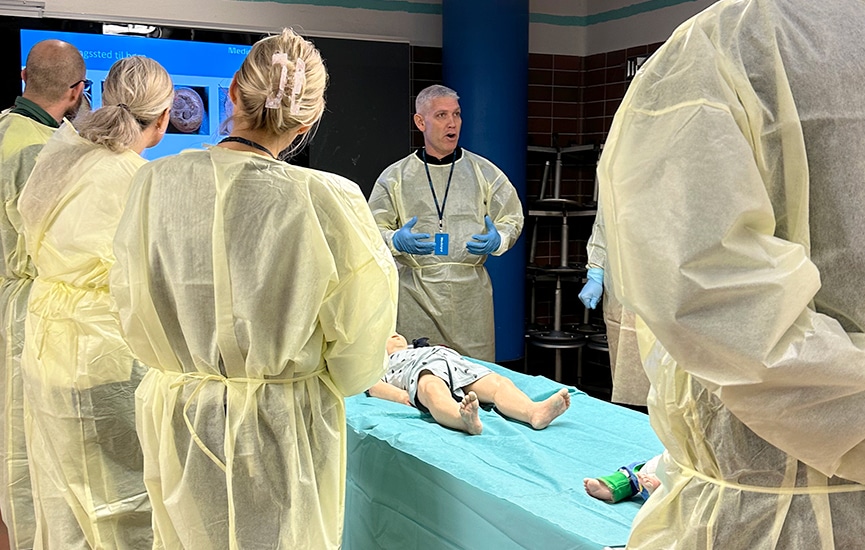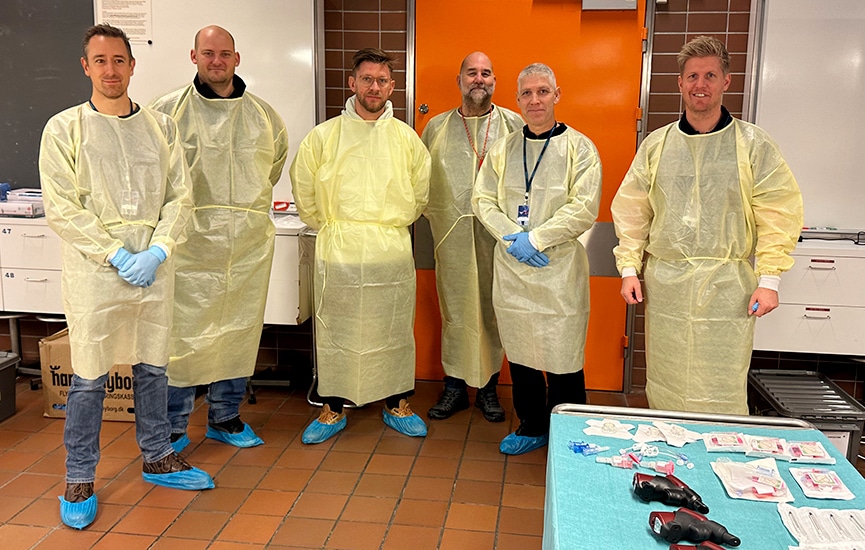On occasion of our latest intraosseous (IO) workshop we thought it fitting to take a closer look at the concept of IO access. In this article you can get introduced to IO access, learn more about why it is effective in emergency medicine, and why you should practice it. We round off with statements from workshop participants, to show that you should not just take our word for it: Hands-on practice makes a difference, not least when working with IO access.
What is intraosseous access and how is it used?
Intraosseous access is a technique that allows clinicians to infuse fluids, blood products, or medications directly into the bone marrow cavity, which is connected to the systemic circulation. This technique can be used when intravenous (IV) access is not feasible or not available, such as in cases of shock, cardiac arrest, severe dehydration, or severe bleeding. In this case IO access can provide rapid and reliable delivery of life-saving interventions in critical situations.
Establishing IO access involves inserting a special needle into the medullary space of a long bone, such as proximal humerus, proximal tibia, and distal tibia. The sternum is only used in military settings and requires a dedicated device. For children, the distal femur can also be used for creating IO access. The needle, that is inserted, is attached to an extension set, and then a pressure infusion bag can be set up, which allows the infusion of fluids or medications. The needle can also be used to obtain blood samples for point-of-care testing or laboratory analysis, which can help to guide the diagnosis and treatment of the patient.
IO access can be performed using manual or battery-powered devices. Medidyne distributes the EZ-IO system in Denmark, Norway, Sweden, and Finland. It is one of the most used battery-powered devices and has different needle sizes for different anatomical sites and different types of patients.
What are the advantages of IO access?
IO access has several advantages over other routes of administration, e.g. central venous catheterization (CVC) and IV access. Here are three of them. First and foremost, it is fast: IO access can be established quickly, usually within seconds to minutes, compared to IV access, which can take longer or fail in critically ill patients. Second, IO access can be used in patients with compromised peripheral circulation, such as those with hypothermia, hypovolemia, or vascular injury. Third, IO access has a low risk of complications, such as infection, extravasation, or embolism, compared to e.g. CVC.
Intraosseous access in prehospital settings
IO devices are widely used in prehospital settings by paramedics, emergency medical technicians, or military personnel, to provide immediate and effective care to patients with life-threatening conditions.
The benefits of IO access in prehospital settings are evident: A study investigating the efficacy of intraosseous access for trauma resuscitation has found, that the success rate on first attempt of IO access was much higher than that of IV access for trauma patients, and the mean procedure time of IO access was significantly less when compared to IV access. Therefore, the study suggests IO access as an urgent vascular access for hypotensive trauma patients, especially those who are under severe shock. A study in England has also found that there has been an increase in use of intraosseous access in out-of-hospital cardiac arrest over time.
Practicing IO procedures
Obtaining IO access is a technique that can make a difference between life and death in emergency situations. However, working with IO access requires proper training and practice to ensure its safe and effective use. A study also suggests that IO access may not be used as much as it could and should be because of a lack of knowledge and training.
IO procedural training is helpful for at least three reasons: First, it helps improve the knowledge and skills of the clinician in selecting the appropriate device, needle, and anatomical site for IO access. Second, it helps increase the confidence and competence of the clinician in performing IO access in a timely and accurate manner. Third, it helps enhance the quality and outcomes of the patient care and management.
You can carry out IO training in different ways, such as with online courses, lectures, workshops, simulations, or hands-on practice on manikins or cadavers. Just be aware that training should follow the local and international guidelines and protocols for IO access.

Michael Byskov teaching the use of EZ-IO on pediatric patients with manikins at the EZ-IO workshop
The EZ-IO workshop
As mentioned, at Medidyne we distribute the fast and effective, battery-powered EZ-IO system. It is our experience that hands-on training makes a great difference to the users of the system. Therefore, we have hosted practical workshops over the years where acute care personnel from across the Nordics get to practice with the EZ-IO system on cadavers.
At our latest workshop in Copenhagen, we received very positive feedback. Read below and learn how hands-on workshops can make a difference.
Christian Anker Rasmussen, Paramedic, said about the workshop: “The instructors’ extensive expertise shone through, and the practical, realistic scenarios on real anatomy added immense value to my skill set.”
Emelie Ekberg, Ambulance Nurse, said: “The workshop exceeded my expectations. The practical scenarios were invaluable, and the skilled instructors ensured a truly enriching learning experience. I left feeling confident and secure about working with IO access.”
Morten Fejrskov Hansen, Ambulance Care Attendant and Medical Assistant, Region Midtjylland, said: “Kudos to the knowledgeable instructors! The IO workshop was not just informative but also engaging. Witnessing the real-time responses of anatomy to interventions added depth to my understanding. A great educational experience.”
Marie B., Nurse, said: “Great workshop with a hands-on focus. The practical sessions were incredibly insightful, allowing participants to apply newfound knowledge and skills directly.”
Whether being a first-time user or an experienced user of IO devices, a workshop can be valuable. Just read what Knud Bentholm, Paramedic and Medical Assistant, said about the EZ-IO workshop:
“The workshop was highly relevant and very educational. It was so good to see how the real anatomy responds to our interventions. I have probably inserted 500 IO needles over the last 10 years, and I still learned a lot. Thank you very much.”
Conclusion
IO access is a valuable technique that can provide rapid and reliable vascular access, when IV access is not feasible or not available. With its speed and efficiency, IO access can help save lives and improve outcomes in prehospital settings. However, working with IO access requires proper training and practice to ensure its safe and effective use. At Medidyne, we regularly arrange IO procedure workshops. The participants highlight the hands-on focus in the sessions as being key to learning.
Would you like to get an invite next time we are hosting an IO workshop? Then sign up for our newsletter.

The team of instructors at the EZ-IO workshop

